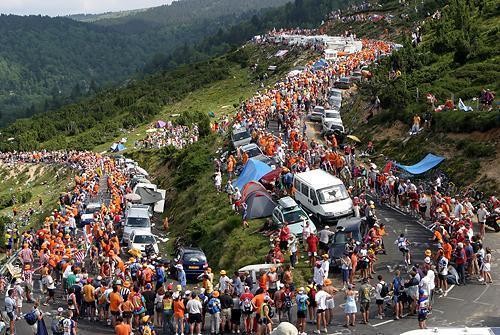The highs and lows of altitude training
Training or living at altitude is a tactic many cyclists use to improve their physiology and prepare...

Fitness feature, January 18, 2005
Training or living at altitude is a tactic many cyclists use to improve their physiology and prepare for races at altitude. In recent years, more research has been carried out on the subject and different theories have developed. Cyclingnews caught up with Dr John Hellemans, a sports medicine practitioner and former athlete based in New Zealand, who has extensive experience on the subject. Dr Hellemans has been invloved in altitude camps as both coach and athlete for many years and provides an overview of altitude training and how to handle it.
Cyclingnews: Basically, why should cyclists train at altitude?
Dr John Hellemans: Various forms of altitude training and altitude simulation are well proven methods to improve endurance performance in many sports. Road cycling is an endurance sport with a high dependency on the aerobic (oxygen dependant) energy systems. Your capacity to process oxygen in an energy efficient way is a deciding factor in cycling performance as it helps you to last longer at a higher average velocity.. If you can improve the amount of oxygen delivered to the working muscle (by increasing the redblood cells) and process it in the most energy efficient manner (by improving the off loading and processing mechanisms), you have an immediate advantage. Altitude training achieves just that. Also, many races, especially at international level, have mountain stages and being acclimatised to altitude will help performance at altitude.
CN: The Australian Institute of Sport did a study whereby they revealed that the advantage of altitude training is not purely in the aerobic system, but rather improves the anaerobic capabilities at the end of a long race. Is this your experience?
JH: Yes, there is some evidence that altitude training improves the buffering mechanism of the blood, which means that higher levels of lactate can be tolerated. Theoretically this results in an improvement especially in explosive power. This is currently being studied in more detail by scientists. One of the side effects of prolonged exposure to more extreme altitudes is a loss of muscle mass which has the opposite effect. The ideal way of training at altitude for this purpose is still to be decided but the “live high-train low” model, where most of the harder training is done at sea level, is likely to prevent the loss in strength but still provide the athlete with an improvement in buffering capacity.
CN: What precautions do you need to take when training at altitude? Do you need to change the way to train when you first arrive and in general?
The latest race content, interviews, features, reviews and expert buying guides, direct to your inbox!
JH:When going on an altitude training camp the main requirements are that you need to make sure that you have already developed a base fitness (it is hard work starting from zero at altitude) and secondly, that you are in good health. In particular, you need good levels of iron stores as iron is one of the building blocks of the red blood cells of which hopefully you will produce a few more.
Usually you need to adapt your training in week one and use that for acclimatisation. The sessions are shorter and do not have a high intensity component. In week two the sessions can be made longer with gradual introduction of some controlled intensity. Week three is then close to sea-level training for the more robust athlete. The more vulnerable athlete never quite reaches the same level of training as they do at sea level and for these athletes the outcome of altitude training is not always favourable. If you do a stint of altitude simulation prior to going to altitude you can shorten the acclimitisation period dramatically and almost go into normal training mode straight away. Also, the more altitude training you do over time the better you will get at it and the better your body will respond; there is an accumulative effect. Hence that many elite athletes have more then one altitude training stint in their program every year.
CN: What precautions off the bike do you need to take when arriving at altitude? For example, do you need to change the way you eat and sleep etc?
JH: Recovery is everything at altitude. Generally your recovery is a bit slower so nutritional measures (including hydration) and rest become even more important to enhance that process. Many athletes lose their appetite at altitude initially and again this needs to be monitored carefully. Dehydration is also not uncommon and frequent weighing should be part of the monitoring process. A heart rate monitor can assist with the monitoring of training intensity and also recovery. Initially, the morning heart rate can be 5-10 beats above that of the rate at sea level. Usually this returns to close to normal within a week, indicating proper acclimatisation.
CN: Do you have any comments on the sleep high, train low theory? That is, to either drive a lot or use an altitude tent?
JH: Much of the research on altitude training over the last few years has focused on the “live high-train low” model and some solid evidence has been presented by scientists like Benjamin Levine and co that this is a safe and effective method of altitude exposure. To prevent the amount of travel required this method can be mimicked with help of the altitude tent or even better intermittent hypoxic training.
The latter is a method of altitude simulation whereby athletes are exposed (via a mask) to short (five minute) bursts of very high altitude air (containing 9-15% oxygen which is comparable to an altitude of 6000-2500m) alternated with normal air, for a total of one to two hour duration every day. This is the “interval” method of altitude training, short bursts of altitude air of “high intensity” over a relative short “training” session (the word training is confusing as iht is done sedentary). One of the problems with the tent is that the quality of sleep is not always that good, especially for the light sleeper. Interestingly the Japanese tend to do the opposite of the Americans and focus their research on the “live low-train high model”, with apparently good results (obviously achieved by a different physiological mechanism of adapation).
CN: What altitude do you think is the most advantageous for athletes who are hoping to gain from it?
JH: The current recommended altitude is around 2500 m, however I have seen excellent results from 1500 m where less side effects are experienced and better quality training can be achieved. It is likely that there is not one ideal level of altitude for all athletes but that individual athletes have their own optimal altitude threshold. Whoever finds out how we can determine the optimal altitude for the individual athlete will win the Nobel Prize for altitude science.
CN: Is there a point where you can go too high?
JH: That depends on which method is used. Especially with conventional altitude training (live high-train high) there are too many side effects when getting to high, which interferes with the training process. The method of intermittent hypoxic training however allows athletes to go to 6000 m for short bursts without any side effects and excellent performance benefits.
CN: How does altitude affect different people?
JH: There is a huge variation in responses to altitude which seems to be genetically determined, although it can be improved by frequent exposure. The ability to maintain relatively high levels of oxygen in the circulating blood seems to have something to do with the ability to tolerate altitude. Contrary to popular opinion, fitness has less to do with the ability to tolerate altitude. Reinhard Messner, the first person to climb Mt Everest without the help of oxygen, still had extremely high oxygen levels in his blood at the top but he was known to have only an average level of aerobic fitness.
CN: What is the optimum amount of time needed at altitude for it to have an affect?
JH: Most changes in relation to adaption to altitude find place in the first three to four weeks. Athletes who have frequent access to altitude exposure often go for shorter stints, for example two weeks. The benefits seem to last up to a month.
CN: It is often seen that people who live at sea level struggle when racing at altitude, giving the athletes who live high an instant advantage. Do you also think people who live high also have an advantage when coming down to Sea Level?
JH: That is an interesting question and the answer is probably yes. However in cycling the velocity of speed achieved is usually higher at altitude compared to sea-level because of the “thiness” of the air and therefore less frontal resistance. At returning to sea level the air initially can feel “heavy” with a perceived drop in performance, a result due to the increase in air resistance. For the highlanders who live at altitude this could be an unsettling experience and he might need a period of sea-level adaption to get used to it.
CN: For people who are going to altitude for the first time, what other hints do you have for them in terms of coping with the change and gaining from their experience?
JH: They have access to an altitude simulator (you can now purchase home units for less then US$1000) I recommend that you use that before going to altitude to minimise the period of adaption and therefore maximise the training effect. Also have a good training base and before you go have a health check including a blood test to check on iron status. If you do it well you will feel amazingly fit. Scientists estimate performance benefits from altitude training to be between one and three percent, which is significant for an elite athlete. It is also accompanied by an amazing feeling of fitness and general wellbeing.
Background: Dr John Hellemans is a well-known New Zealand sports medicine practitioner, coach and altitude consultant. He has a strong interest in altitude training and the effects it has on health and performance. John founded the New Zealand Triathlon High Performance Programme in 1996. Altitude training and altitude simulation have been strong components of the programme contributing to the successes of the New Zealand Triathlon Team.
John is a competitive cyclist and triathlete himself, having won 6 World Championship Age Group titles since 1990. Most recently John won his age group division (50-55) in the Holland Ironman Triathlon. John has coached world champions, Olympic triathletes, as well as age group triathletes and cyclists. In his capacity as a coach John has attended multiple altitude training camps all over the world. John is leading an international cycling/triathlon altitude training camp over one of the highest sealed roads in the world from sea-level in Chile to La Paz in Bolivia wich is at 3500m (see also www.bike-nz.com)
More fitness features

